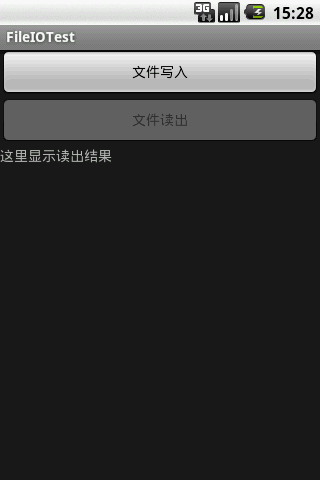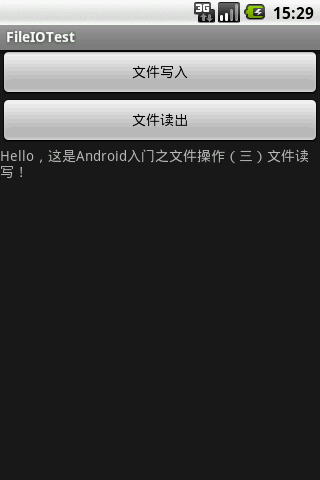

- import java.io.*;
- import android.app.Activity;
- import android.os.Bundle;
- import android.view.View;
- import android.view.View.OnClickListener;
- import android.widget.*;
- public class FileIOTest extends Activity {
- private LinearLayout mainView=null;
- private Button writeButton=null;
- private Button readButton=null;
- private TextView tv=null;
- public void onCreate(Bundle savedInstanceState) {
- super.onCreate(savedInstanceState);
- writeButton=new Button(this);
- writeButton.setText("文件写入");
- writeButton.setOnClickListener(new OnClickListener(){
- public void onClick(View v) {
- fileWrite();
- }
- });
- readButton=new Button(this);
- readButton.setEnabled(false);
- readButton.setText("文件读出");
- readButton.setOnClickListener(new OnClickListener(){
- public void onClick(View v) {
- fileRead();
- }
- });
- tv=new TextView(this);
- tv.setText("这里显示读出结果");
- mainView=new LinearLayout(this);
- mainView.setOrientation(LinearLayout.VERTICAL);
- mainView.addView(writeButton);
- mainView.addView(readButton);
- mainView.addView(tv);
- setContentView(mainView);
- }
- /*文件写*/
- void fileWrite(){
- //File file=this.getFilesDir();//打开私有目录
- File file=new File("/sdcard");
- String path=file.getAbsolutePath();//获取路径
- String name="mydata1.dat";//新建文件名
- File filex=new File(path,name);
- //如果文件不存在,则创建一个文件
- if(!filex.exists()){
- try {
- filex.createNewFile();
- } catch (IOException e) {
- e.printStackTrace();
- }
- }
- //获取文件输出流
- FileOutputStream fos=null;
- try {
- fos=new FileOutputStream(filex);
- byte buf[]="Hello,这是Android入门之文件操作(三)文件读写!".getBytes();
- //上面涉及到字符串转字符,为了保证编码正常,建议采用下面的方法
- //ByteArrayOutputStream baos=new ByteArrayOutputStream();
- //DataOutputStream dos=new DataOutputStream(baos);
- //try {dos.writeUTF("XXXXXXXXXXXXXXXXX");catch (IOException e1) {e1.printStackTrace();}
- //byte[] buf=baos.toByteArray();
- try {
- fos.write(buf);//全面覆盖式的写,如果要添加或者修改,得把原来的先读出来再做处理
- fos.close();
- } catch (IOException e) {
- e.printStackTrace();
- }
- } catch (FileNotFoundException e) {
- e.printStackTrace();
- }
- readButton.setEnabled(true);
- }
- /*文写读*/
- void fileRead(){
- //File file=this.getFilesDir();//打开私有目录
- File file=new File("/sdcard");
- String path=file.getAbsolutePath();//获取路径
- String name="mydata1.dat";//新建文件名
- File filex=new File(path,name);
- //
- try {
- FileInputStream fis=new FileInputStream(filex);
- byte buf[]=new byte[1024];
- try {
- int len=fis.read(buf);
- fis.close();
- } catch (IOException e) {
- e.printStackTrace();
- }
- //显示读取结果
- tv.setText(new String(buf));
- //上面涉及字符转字符串,为了保证编码正常,建议采用下面的方法
- //ByteArrayInputStream bais=new ByteArrayInputStream(buf);
- //DataInputStream dis=new DataInputStream(bais);
- //try {tv.setText(dis.readUTF());} catch (IOException e) {e.printStackTrace();}
- } catch (FileNotFoundException e) {
- e.printStackTrace();
- }
- }
- }